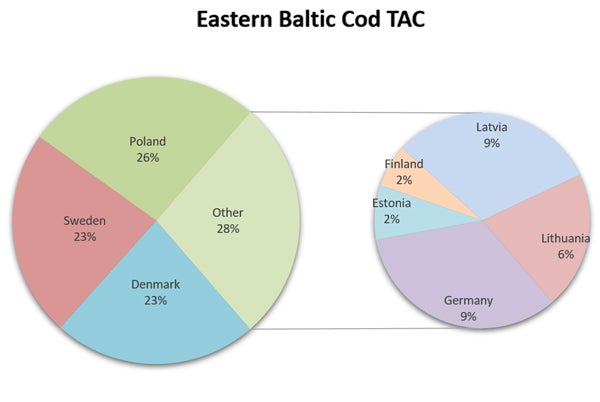Eastern Baltic Cod
Eastern Baltic Cod
A COLLAPSED STOCK
Due to the stock’s extremely poor condition, the European Commission ordered emergency fishing measures to be put in place following the collapse of the eastern Baltic cod population. The temporary ban to fish eastern Baltic cod will last until December 2019. However, Oceana stresses that a long-term action is crucial to gaurantee its proper recovery.
STOCK STATUS
 The cod stock in the eastern Baltic has historically been much larger than the neighbouring western stock, from which it is biologically distinct. The eastern cod stock is in a critical condition and it has been widely recognized that it has collapsed. It has been suffering from a fishing mortality well above sustainable levels and the biomass has been below the Blim reference point (which means that the stock is at a high risk of suffering from reduced recruitment, a state that should be avoided at all cost) for several years now. In fact, in the mid-term, it is estimated that even at a no fishing scenario, it will remain below the reference points due to incredibly high natural mortality. The International Council for the Exploration of the Sea (ICES) noted that “fishing at any level will target the remaining few commercial sized (>=35 cm) cod; this will deteriorate the stock structure further and reduce its reproductive potential.” It is therefore vital to take any and every measure possible to preserve the future of this stock.
The cod stock in the eastern Baltic has historically been much larger than the neighbouring western stock, from which it is biologically distinct. The eastern cod stock is in a critical condition and it has been widely recognized that it has collapsed. It has been suffering from a fishing mortality well above sustainable levels and the biomass has been below the Blim reference point (which means that the stock is at a high risk of suffering from reduced recruitment, a state that should be avoided at all cost) for several years now. In fact, in the mid-term, it is estimated that even at a no fishing scenario, it will remain below the reference points due to incredibly high natural mortality. The International Council for the Exploration of the Sea (ICES) noted that “fishing at any level will target the remaining few commercial sized (>=35 cm) cod; this will deteriorate the stock structure further and reduce its reproductive potential.” It is therefore vital to take any and every measure possible to preserve the future of this stock.
BALTIC COD STOCKS EXPLOITATION AND ECONOMIC RELEVANCE
 For several years the Western stock observed a continuous decline in annual TACs (by -40% overall since 2012), followed by inevitable decline in annual catches. The fragile Eastern cod stock with its own set of problems has also recently been targeted by TAC reductions. Altogether the two Baltic cod stocks landings decreased in both weight and value (9% and 15%, respectively) between 2013 and 2014.
For several years the Western stock observed a continuous decline in annual TACs (by -40% overall since 2012), followed by inevitable decline in annual catches. The fragile Eastern cod stock with its own set of problems has also recently been targeted by TAC reductions. Altogether the two Baltic cod stocks landings decreased in both weight and value (9% and 15%, respectively) between 2013 and 2014.
The decreased landings and poor physical condition (skinny fish) negatively influencing the market value has led to once prominent and most commercially important species in the Baltic Sea plummeting. In 2012 Baltic cod fishery generated the highest value of landings (€77 million), followed by herring (€64 million), and then sprat (€45 million). Just two years later, in 2014 herring generated the highest value (€71 million, representing 36% of the landed value), followed by European sprat (€52 million, 26% of the landed value) and then cod (€35 million, 16% of landed value).


